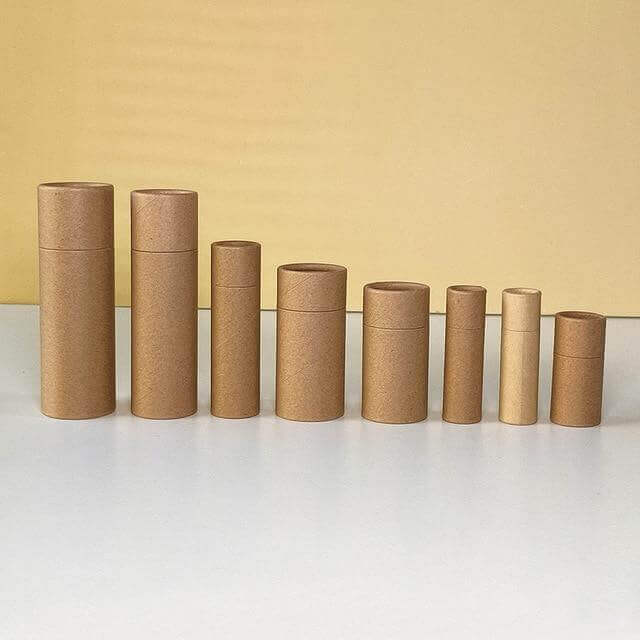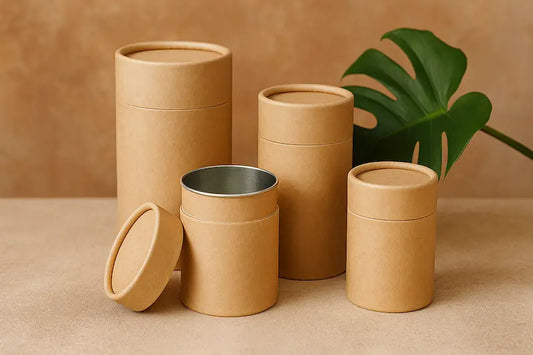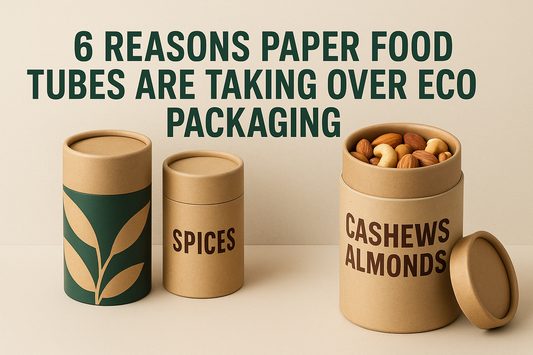Paper Canister Buying Guide: How to Choose the Right Eco-Friendly Packaging for Your Products
Aktie
At Esytube, we’ve helped hundreds of food, cosmetic, and gifting brands create custom eco-friendly paper canister packaging that meets both sustainability goals and shelf appeal.
As sustainability becomes a central concern for modern businesses, eco-friendly packaging is no longer optional—it's expected. Among the various green packaging solutions available today, paper canisters (also known as paperboard jars) stand out for their biodegradability, versatility, and premium appearance.
In this guide, we’ll walk you through everything you need to know to choose the right paper canister for your product, from material types to moisture barriers and branding options.
1. Introduction: Why Paper Canisters Are Gaining Popularity
As brands move toward plastic-free, aesthetically pleasing, and eco-responsible packaging, paper canisters are gaining ground across cosmetics, food, and gifting sectors. These cylindrical tubes offer both structural function and branding value, making them ideal for products like lip balm, tea, and small gifts.
II. What is a Paper Canister?
A paper canister is a round, tube-shaped container made primarily of cardboard or kraft paper. Its basic structure includes:
Paper Shell (Outer Tube)
Inner Liner (Optional PE or Aluminum Foil for Protection)
Top Lid (Cardboard, Metal, or Plastic)
Common Applications:
Cosmetics: lip balm, deodorant, solid perfume
Food: tea, spices, snacks, coffee
Gifting: candles, crafts, small accessories, seasonal gift sets
III. Key Factors to Consider When Choosing a Paper Canister
1. Material Grades: Choose the Right Paperboard
Different products require different levels of durability and protection. Here are 4 popular types of paperboard:
Whiteboard: Clean, smooth finish, good for printing
Kraft Board: Brown, natural look, ideal for eco-conscious brands
Grey Board: Recycled material, cost-effective
Coated Board: Water-resistant, smoother texture

Also consider food-grade vs. industrial-grade materials, especially for edible or skin-contact products.
2. Size and Volume: Match Packaging to Product
Choosing the right canister size ensures both practicality and cost-efficiency. For example:
Lip Balm: 5g, 10g push-up tubes
Deodorant: 15g–60g twist-up tubes
Tea/Spices: 50ml–250ml wide canisters
3. Barrier and Sealing Options: Protect Product Freshness
If your product is sensitive to moisture, air, or oil, consider canisters with:
PE Liners: Basic moisture resistance
Aluminum Foil Liners: High barrier for food-grade applications
Inner Sealing Discs: For added freshness
4. Printing and Branding Options: Stand Out on the Shelf
Paper tube packaging offers 360° full-wrap design, giving brands a powerful canvas to communicate identity and values. Here are common decoration techniques and their unique advantages:
Offset or UV Printing
Best for high-quality, full-color designs with fine detail. UV printing offers fast drying and vibrant color, especially useful for glossy or dark papers.
Hot Foil Stamping (Gold, Silver, etc.)
Adds a luxurious, reflective metallic finish—perfect for premium lip balm lines or holiday gift editions.
Laser Engraving
Provides a clean, tactile effect by etching directly onto the paper surface. Ideal for eco-conscious brands seeking a minimalistic and plastic-free look.
Embossing & Spot UV
Embossing adds raised texture, giving packaging a premium, touchable quality. Spot UV highlights specific areas like logos or text with a glossy sheen, increasing shelf appeal.
5. Customization Services and MOQ
For B2B customers, we offer:
Flexible MOQ starting from 1,000 pcs
Custom die-cut sizing
Structural engineering for special formats
Branding consultation services
6. Sustainability Benefits: Why Choose Paper Canisters?
Paper canisters are:
Biodegradable & Recyclable
Made from renewable resources
A compelling alternative to plastic jars or aluminum tins
They allow your business to meet environmental standards while boosting consumer trust.
IV. Popular Applications of Paper Canisters
Beauty & Personal Care: Lip balm tubes, deodorant sticks, solid shampoos
Food Industry: Loose leaf tea, coffee, powder, dried fruit
Gift Packaging: Promotional kits, handmade goods, candles, holiday gift boxes
These industries are embracing paper canisters not only for sustainability but also for their premium, minimalist look.
Conclusion Why Paper Canisters Make Business & Environmental Sense
Choosing the right packaging is no longer just about aesthetics or cost—it’s about aligning your product with consumer expectations, regulatory standards, and brand values.
Paper canisters deliver on all fronts:
Functional: Durable, protective, and customizable to your product Sustainable: Biodegradable, recyclable, and made from renewable resources
Brand-Ready: Fully printable and premium in look and feel
Whether you're launching a new natural deodorant, rebranding your tea series, or designing eco-conscious gift kits, paper canisters offer a future-proof, planet-friendly solution that resonates with today’s conscious consumers.
FAQs
1. What is a paper canister made of?
Paper canisters are typically made of cardboard or kraft paper, often with an inner liner and a lid for sealing.
2. Can paper canisters be customized with my brand logo?
Absolutely. Paper canisters can be fully customized with printing, embossing, foil stamping, and more.
3. Are paperboard jars recyclable and eco-friendly?
Yes, most paperboard jars are recyclable and biodegradable, making them a sustainable packaging choice.
4. What sizes are available for lip balm paper tubes?
Common sizes include 5g, 10g, and 15g tubes, but custom sizes are also available upon request.
5. Do paper canisters provide moisture protection?
They can, especially when equipped with aluminum foil or PE liners for added moisture resistance.




